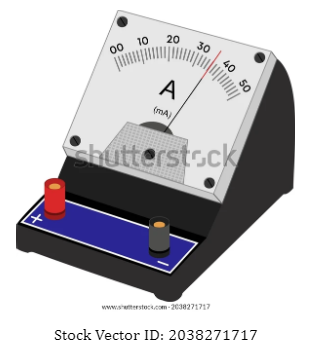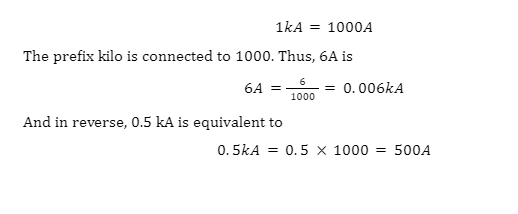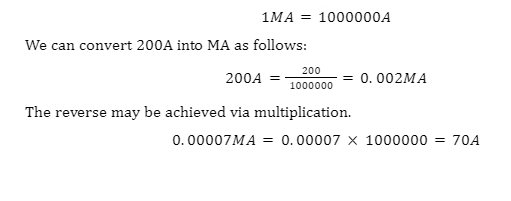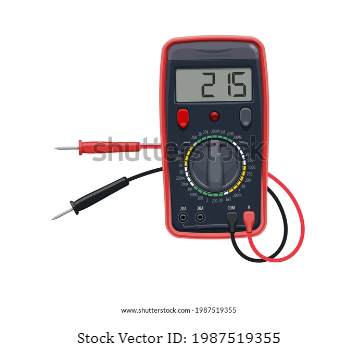Introduction
The Ampere is one of the seven fundamental units, which include metre, kilogram, second, Kelvin, mole, and Candela. It is used to measure the flow of electric current and is abbreviated as A or amp. Different systems of units like KGS, CGS, and International SI use different units for current and other basic quantities, and conversions can be made between these units.
An ammeter is a device that measures electric current in amps flowing through a circuit.

What is Ampere?
Ampere, named after Andre-Marie Ampere, is a unit used to measure electric current. It is abbreviated as amp or A. Ampere was a French physicist and mathematician and is considered the father of electromagnetism.
Initially, the unit Ampere was defined as an electric current equivalent to the flow of \({10^{19}}\) elementary charges in 1.602176634 seconds. Later, the unit of charge was defined as the coulomb, and Ampere was defined as the flow of one coulomb of charge per second.
1A = 1 C \({\sec ^{ – 1}}\)
A – Ampere (unit of current)
C – Coulomb (unit of charge)
s – second (unit of time)
In the CGS system, the unit of electric current is the “statampere,” which is approximately equal to 10-10 A, while in the International System of Units (SI), one Ampere is defined as the flow of one coulomb of charge per second.
Prefixes of Ampere
To reduce the number of zeros in numerical equivalences, multiples and submultiples of units can be used. These are commonly expressed using prefixes and we list a few here.

The most common of these are A, kA, MA, mA, and μA and conversion between these sub units is easy.
Ampere Conversion Table
Conversion of Ampere into milliampere

Conversion of Ampere into microampere
Conversion of Ampere into kiloampere
Conversion of Ampere into Megaampere
Conversion of Watt, Volt, and Ohm into Ampere
Conversion of Watt into Ampere
Unlike Ampere, Watt is a unit of power and we can calculate power from current as follows:

Without knowing voltage or resistance, power cannot be calculated solely from the current. For instance, for a device consuming 3000W of power at 100V, the current is:
Conversion of volt into Ampere
Once again, Volt is a unit of voltage, not current. We can calculate voltage from current given either the power or the resistance. Here is an example. For a 400W devices operating at 20V, the current is:
Conversion of ohm into Ampere
Ohm measures resistance and Ohm’s law states that
Ammeter
An ammeter is an electronic device designed to measure the flow of electric current in a circuit, which is usually measured in amperes and thus, the name ammeter is given to them. To measure the current, ammeters are connected in series with the circuit and owing to their low resistance, they do not experience significant voltage while performing the measurement.
Ammeters are available in different ranges, with some used to measure smaller currents in the milliampere (mA) or even the microampere (μA) range. They can be designed to measure both AC as well as DC current.
Types of Ammeter
Ammeters are classified as below
- Moving coil ammeter
- Electrodynamic ammeter
- Moving iron ammeter
- Digital ammeter
- Hotwire ammeter
- Integration ammeter
1. Moving coil ammeter
A moving coil ammeter is a type of ammeter that can measure both AC and DC current using magnetic deflection. As implied by the name, the coil in this ammeter rotates freely between permanent magnets, owing to the interaction between the current passing through the coil and the magnetic field across it. The current flowing through the circuit is denoted by a pointer connected to this coil.
2. Electrodynamic ammeter
This ammeter can also measure AC and DC current with an accuracy of 0.10% to 0.25%. The field produced by a fixed coil is used to rotate another coil here, which can denote the value of current.
3. Moving iron ammeter
This type of ammeter can also work on both AC and DC. Here, a specially prepared soft iron moves freely between the poles of a permanent magnet or electromagnet. It can be further classified into repulsion or attraction type.
4. Digital ammeter
A digital ammeter displays the exact value of the current on a digital display. To measure the current, a shunt resistor is added in series with the circuit, and the voltage across the shunt is calibrated to correspond to the current. The voltage is then converted to a digital signal using an analog-to-digital converter and displayed on the screen.
5. Hot wire ammeter
The heat produced across the wire causes it to expand, which can measure the value of AC or DC current across the circuit.
Summary
The ampere is the standard SI unit of electric current, and is defined as the flow of electric charge in an electric circuit. An ammeter is an instrument used to measure the flow of current in a circuit, and can measure current in a wide variety of subunits like milliamperes, microamperes, and nanoamperes. Ammeters can work in AC and DC circuits.
Current measured in amperes can be converted into milliamperes, microamperes, and nanoamperes, and one can calculate the power and resistance in circuits given two of the three quantities (voltage, current, resistance). Various types of ammeters, such as moving coil ammeters and digital ammeters, are available to measure current in different scenarios.
Frequently Asked Questions
1. What does Ampere denote?
André-Marie Ampère, a French physicist and mathematician, is considered the father of electromagnetism and the unit of current, ampere (amp), was named after him. One ampere is defined as the flow of one coulomb of charge per second.
1A = 1C / 1s
2. List two advantages of digital Ammeters over analog ones.
Given below are two advantages of a digital ammeter.
- Digital ammeters can even work with a small power supply and their accuracy is very high.
- They are reliable, economical, and last a longer period of time.
3. Why is the connection of the ammeter necessarily in series? What would happen if we connected it in parallel?
An ammeter is a device that measures the current flowing in a circuit, typically measured in amperes. To accurately measure the current, the ammeter must be connected in series with the circuit components.
Connecting an ammeter in parallel would result in a drastic increase in current since the resistance is very low, which can generate excess heat and potentially harm the device.
4. Discuss the working of a moving coil ammeter?
A moving coil ammeter is one of the various types of ammeter that can measure both AC and DC current. It uses magnetic deflection, with a coil that rotates freely between permanent magnets. The interaction of magnetic field produced with the magnetic field of the magnets causes a deflection in the coil, which can denote current flow.
5. How to convert a moving coil galvanometer into an ammeter?
A moving coil galvanometer can be converted into an ammeter by connecting a low resistance in parallel with it.
 Mission Statement
Mission Statement
“Empower every student to achieve full potential”
88Guru has been established with the social objective of making quality video-based learning material available to all Indian students. Technology, Connectivity and Social Media are rapidly changing the world of Education and we wish to lead the transformation of the tuition industry in India.
88Guru is the perfect complement to the current tuition model. 88Guru creates a wonderful opportunity for children and parents to bond while engaging in a valuable learning activity. It also provides the complete curriculum at your fingertips for those moments when you need some help at short notice. We believe that this mode of tuition could be transformational, adding hours to a child's day while providing complete control over the learning process.
Every course is taught by the best teachers from India's top schools and conducted in an engaging manner to keep students involved. The e-learning process consists of video-based instructions, computer-graded assignments, and a dashboard which allows the student and parent to track progress.









